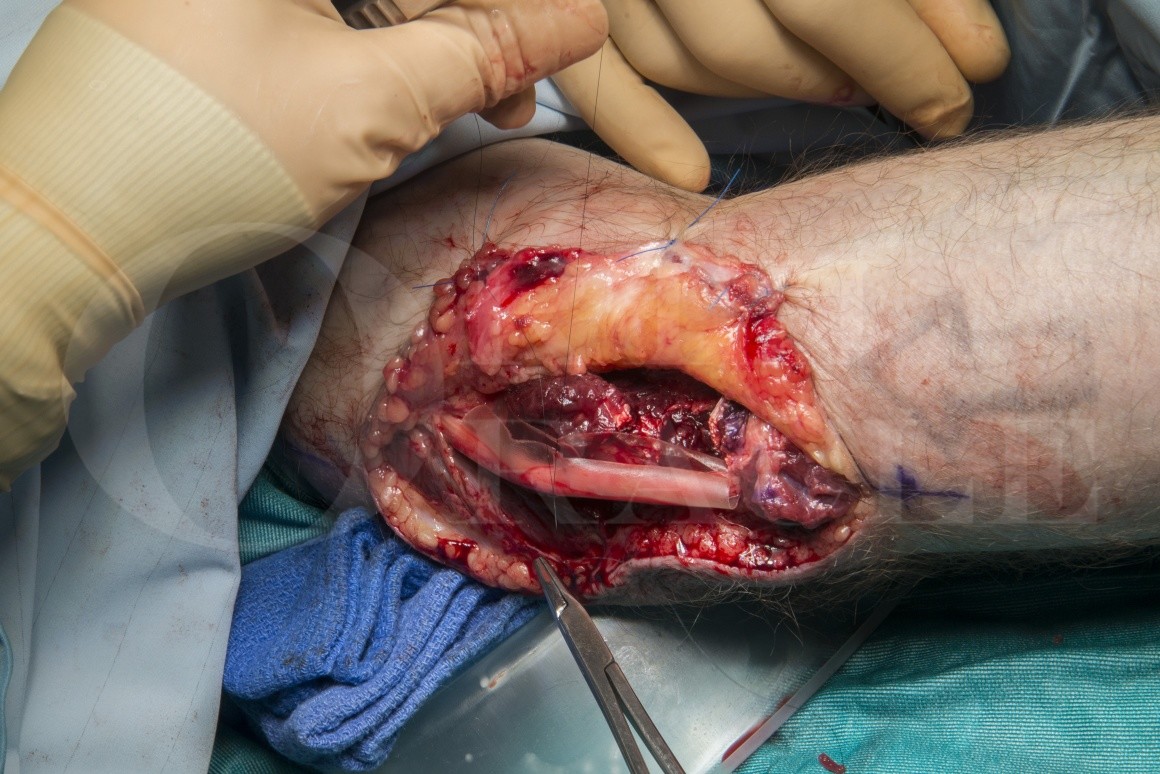Cubital tunnel decompression: Revision with submuscular transposition and application of Axoguard
Overview

Subscribe to get full access to this operation and the extensive Shoulder & Elbow Surgery Atlas.
Learn the Cubital tunnel decompression: Revision with submuscular transposition and application of Axoguard surgical technique with step by step instructions on OrthOracle. Our e-learning platform contains high resolution images and a certified CME of the Cubital tunnel decompression: Revision with submuscular transposition and application of Axoguard surgical procedure.
Cubital tunnel syndrome is compression of the ulnar nerve around the elbow. Unlike carpal tunnel syndrome, the pathology in cubital tunnel syndrome can be variable. The common causes are due to extrinsic soft tissue constriction. Often due to a tight band called Osborne’s ligament (which extend between medial epicondyle and olecranon), tight medial upper arm fascia, a tight fascia over the Flexor carpi ulnaris (FCU) muscle or even a combination of these.
A proportion of patients also have high tensile forces exerted across the nerve during elbow flexion, most pronounced in those with a cubitus valgus deformity.
Patients with cubital tunnel syndrome are managed based on the severity of their symptoms. The commonly used grading system by McGowen is of use in evaluating the symptoms and is a validated grading system.
Grade 1: Sensory symptoms
Grade 2: Constant sensory symptoms with muscle weakness
Grade 3: Muscle atrophy
(McGowan AJ. The results of transposition of the ulnar nerve for traumatic ulnar neuritis. J Bone Joint Surg Br. Aug 1950;32-B(3):293-301).
Those with intermittent symptoms can be managed with activity modification and nerve gliding exercises.
If the symptoms are persistent, or if motor symptoms develop, surgery should be considered. Surgery is aimed at decompressing the nerve by releasing all restrictive structures. If the nerve appears to be subluxing over the medial epicondyle on elbow flexion or there appears to a significant tension on the nerve, then a transposition or medial epicondylectomy may be considered along with the decompression. Transposition can be carried out in the subcutaneous, submuscular or intramuscular planes. The choice of the procedure is often determined by the surgeons preference.
If the symptoms do not resolve following a primary cubital decompression, revision surgery may be considered. Revision surgery is usually a neurolysis and either a transposition or a medial epicondylectomy.
The case described here is of a patient who underwent a primary cubital tunnel release with temporary improvement in his symptoms. The procedure described is a revision cubital tunnel release with nerve wrapping using Axoguard(manufactured by Axogen)which is a neuroprotective membrane that reduces post operative adhesion formation, and a submuscular transposition.
The AxoGuard nerve protector is made from layered porcine extracellular matrix and provides protection from scar formation and adherence to surrounding tissues. Rapid revascularisation allows soft tissue incorporation and restores nerve gliding.
Readers will find the following OrthOracle surgical techniques also of interest:
Cubital tunnel decompression: In-situ distal to proximal release of the ulnar nerve
Cubital tunnel decompression with medial epicondylectomy
Author: Mr Rajive Jose FRCS
Institution: The Queen Elizabeth Hospital ,Birmingham ,UK.
Clinicians should seek clarification on whether any implant demonstrated is licensed for use in their own country.
In the USA contact: fda.gov
In the UK contact: gov.uk
In the EU contact: ema.europa.eu



















